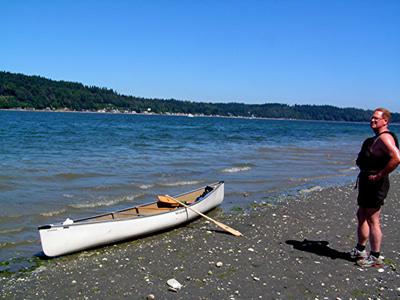 When sudden wind thrashes your canoe, it's time to wait out the storm or portage. This day, it was easy - pack a lunch and enjoy a little sunshine on the beach.
When sudden wind thrashes your canoe, it's time to wait out the storm or portage. This day, it was easy - pack a lunch and enjoy a little sunshine on the beach.When we first started canoeing, we tipped over once! It was in a drainage creek, in the middle of winter. George was trying to turn the canoe to reverse our direction so we could head back into Puget Sound. Fortunately, it was a shallow creek, and we were wearing rubber boots and wool socks. We got our feet just a little bit wet, and learned not to attempt turns in small, fast-flowing water!
I rarely canoe in cold, winter weather anymore. We've done it, and it is beautiful, especially if the snow is falling, and wild snow geese are just a hundred feet away. The isolation is a little spooky, but, if you want adventure you overcome your fears and head out. We've seen a lot of deer, elk, coyotes, beaver and muskrat, and all sorts of wild migrating birds. Thats possible because of the remote locations and wildlife refuges that are good canoeing locations. Oregon, Montana, Washington and Idaho have excellent locations for exploring in a canoe.
Winter factors in more danger because of capsizing. The wind in Puget Sound can be sudden and unpredictable. I've done research on hypothermia, and it can kill quick. It's not that you just get so cold that you die. The cold blood in your veins circulates up to your heart and causes a heart attack.
So, remember, never rub or massage cold legs or arms, or start walking to warm up. It will circulate cold blood up to your heart. That'll kill you quicker than anything. Sit down, build a fire, take off all your wet clothes, wrap up in a warm blanket, and remain still. Let someone else go for help. Always carry a thermos of hot water to drink.
These measures keep you safe. Always take time to plan for emergencies...and, if you have children, they are counting on you to know what to do.